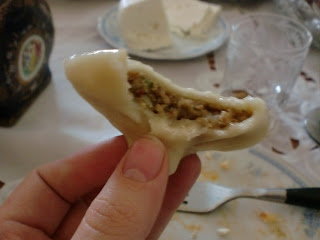One Sunday, my host grandmother was in the kitchen cooking up a storm, which is typical when she comes to visit. I was feeling guilty about being lazy so I looked through my phrase book and attempted to ask how I could help. My younger host sister went to the phone to call someone who speaks English to give me an answer. The answer was “You can do anything you wish.” The grandmother then took off her apron and put it on me, I tried to say that wasn’t necessary, but how could I refuse. We were going to make Khinkali.
Khinkali are meat filled dumplings that Georgians would say every good Georgian woman knows how to make. How many Khinkali you can eat is basically a measure of one’s manliness (as is how much alcohol one can drink).
(the dough)
By the time I was in the kitchen ready to help, the grandmother had already ground and seasoned the meat and started to make the dough. She wanted me to taste the meat. So far on this adventure this may be the first time I have been rude enough to turn down food. She had a wad of uncooked meat on her finger and she tried to shove it into my mouth. I had to turn this down; I am just not sure I can handle that much raw, unknown to me, meat. I have adjusted well to unpasteurized milk, and the apparent optional refrigeration for many foods I think should be refrigerated, but I have to draw a line somewhere. My line is unidentified, raw, ground meat.
(the meat)
(the rolled out dough)
So now I was in the kitchen, dressed to cook, and told I could do whatever I wished. My lack of Georgian was not a huge problem in helping in the kitchen. In fact, my nine-year-old host sister got kicked out because she couldn’t do it right, and I got to stay. We kneaded the dough, that’s pretty standard and the same for many things. It always reminds me of my college pottery class, even though I was cooking before I ever took that class.
Next we rolled out the dough, and turned a glass upside down to cut out the circles that would be used to hold the meat. On every circle we spooned some meat mixture. I am not sure I can use words to describe how they are folded together. I was never told with words, but just shown. You pick up an outer edge of the circle and press it together little by little with the dough right next to it, until you have completed the circle, and have a little knob on top. Then you hold it by this knob with your thumb and pointer finger, and make circular motions with your wrist. Then the khinkali is formed.
(stirring)
(finished products)
After all the khinkali were made we gently placed them knob side down in highly salted boiling water. Stirring occasionally with the handle of a wooden spoon--spoon end is too big and could break them open. My understanding was that they are done when they float. After they were done we feasted. They are great with a little black pepper. They are finger food. They are very juicy. And you don’t eat the little knob.






No comments:
Post a Comment